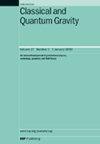连续引力波贝叶斯因子的解析弱信号近似
IF 3.7
3区 物理与天体物理
Q2 ASTRONOMY & ASTROPHYSICS
引用次数: 0
摘要
通过将h -先验建模为具有尺度参数h的半高斯分布,我们推广了连续引力波的目标-统计量。该方法保留了四个振幅边缘积分中的两个的解析可追溯性,并在强信号极限()中恢复了标准-统计量。通过泰勒扩展弱信号域(),新的先验能够完全分析振幅边缘化,从而产生一个简单,显式的统计,其计算效率与最大似然统计一样高,但显着更健壮。数值测试表明,对于长达一天的相干搜索,弱信号贝叶斯因子达到了与统计量相当的灵敏度,尽管略低于标准统计量(和贝罗-惠兰近似)。在短段(与一天相比)的半相干搜索中,这种近似匹配或优于加权主导响应统计量,并返回到较长段(加权)统计量的灵敏度。总的来说,新的贝叶斯因子近似在我们测试的大范围段长度(从900秒到10天)内展示了最先进的或改进的灵敏度。本文章由计算机程序翻译,如有差异,请以英文原文为准。
Analytic weak-signal approximation of the Bayes factor for continuous gravitational waves
We generalize the targeted -statistic for continuous gravitational waves by modeling the h0-prior as a half-Gaussian distribution with scale parameter H. This approach retains analytic tractability for two of the four amplitude marginalization integrals and recovers the standard -statistic in the strong-signal limit ( ). By Taylor-expanding the weak-signal regime ( ), the new prior enables fully analytic amplitude marginalization, resulting in a simple, explicit statistic that is as computationally efficient as the maximum-likelihood -statistic, but significantly more robust. Numerical tests show that for day-long coherent searches, the weak-signal Bayes factor achieves sensitivities comparable to the -statistic, though marginally lower than the standard -statistic (and the Bero-Whelan approximation). In semi-coherent searches over short (compared to a day) segments, this approximation matches or outperforms the weighted dominant-response -statistic and returns to the sensitivity of the (weighted) -statistic for longer segments. Overall the new Bayes-factor approximation demonstrates state-of-the-art or improved sensitivity across a wide range of segment lengths we tested (from 900 s to 10 days).
求助全文
通过发布文献求助,成功后即可免费获取论文全文。
去求助
来源期刊

Classical and Quantum Gravity
物理-天文与天体物理
CiteScore
7.00
自引率
8.60%
发文量
301
审稿时长
2-4 weeks
期刊介绍:
Classical and Quantum Gravity is an established journal for physicists, mathematicians and cosmologists in the fields of gravitation and the theory of spacetime. The journal is now the acknowledged world leader in classical relativity and all areas of quantum gravity.
 求助内容:
求助内容: 应助结果提醒方式:
应助结果提醒方式:


